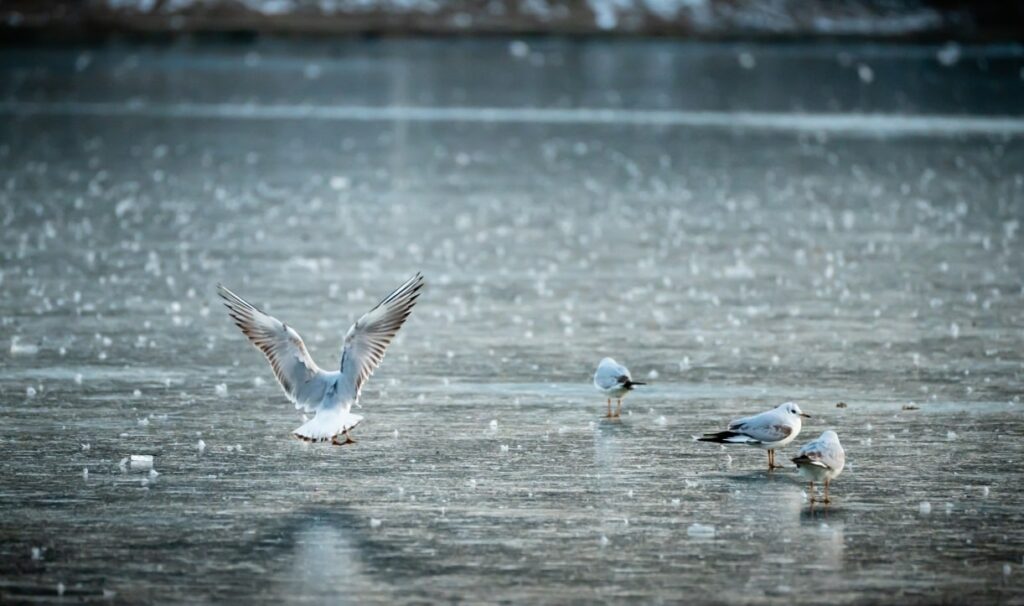Lucky are the birds that fly south for the winter, aren’t they?! Despite having to cross thousands of miles of sky, these migratory species enjoy the warmth of the South while others stay put in the winter cold. But how do these non-migratory species, in fact, survive the freezing temperatures? Do birds ever get cold?
Birds have excellent adaptations for preserving and generating body heat. Some grow an additional layer of feathers, while others fluff up their feathers to form pockets of warm air. Some species huddle to stay warm, shiver, regulate warm blood circulation, or rely on torpor, a state of decreased physiological activity.
Too many details, indeed! But what can we do?! Birds are majestic creatures – it’s not a surprise they have so many curious adaptations! But no worries, we’ve discussed each in detail below, so keep reading!

Do Birds Get Cold in the Winter?
Birds are warm-blooded animals, just like humans. This means they have a constant body temperature. Other animals, reptiles, for instance, are cold-blooded animals, and their body temperature depends on the temperature of their environment.
A bird’s regular temperature is around 106 degrees Fahrenheit. As such, even during winter, a bird’s body temperature doesn’t drop below this because these incredible creatures have developed multiple heating strategies that allow them to stay warm even in freezing temperatures.
Insulation
Many bird species grow an additional layer of feathers when the weather gets worse. This set of downy feathers acts as insulation. Grouse, for example, get additional feathers in winter even on their legs and toes.
Northern cardinals resort to a different type of insulating technique. They fluff up their down feathers. This way, they minimize heat loss.
Besides feathers, birds staying put for the winter prepare beforehand for the cold and put on additional fat that eventually serves as an insulator and energy source. These birds usually increase their intake of seeds and berries when temperatures start dropping and decrease their foraging once cold sets in.
However, since they require much energy to preserve body heat, they still need to feed, which is why homeowners are highly encouraged to set up bird feeders during winter. This facilitates the feeding process and limits the movements birds engage in while foraging.
Sharing Warmth
Many birds huddle to share their body warmth. This way, they also limit the surface area that’s exposed to the cold. Moreover, many species were observed tucking in their heads and feet.
Tree swallows, for instance, are known to crowd together in evergreen trees. Nuthatches do the same. They’ve been observed huddling in crowds of up to 170 birds!
Shivering
This may sound like a natural behavior – after all, humans shiver, too, right?! Well, bird shivering isn’t exactly the same as human shivering. Birds shiver by activating opposing muscle groups. This way, muscles are contracted, the metabolic rate is increased, and more body heat is generated. Specialists suggest that chickadees are experts in shivering.
Regulating Warm Blood Circulation
That’s definitely the most scientifically curious adaptation! Some birds are known to be able to keep the vital organs warm and allow the extremities to cool down. They do so by keeping the warm blood around the important organs.
Take gulls, for instance. They’re known for being able to withstand standing with their feet in freezing-cold water by relying on a countercurrent heat exchange system. Moreover, since bird feet have little muscle or nerve tissue in their feet, they do much better than humans in standing in cold water or snow.
Torpor
We’ve already stated that a bird’s temperature during winter wouldn’t typically drop below 106 degrees Fahrenheit. However, some species drop their body temperature on purpose to avoid freezing.
This phenomenon is called torpor and is characterized by decreased physiological activity that results in a slower metabolic rate and reduced body temperatures.
One of the birds that exhibit this behavior is the black-capped chickadee, which is known to reduce its body temperature by as much as 53 degrees Fahrenheit on cold winter nights. Cardinals are known to be able to lower their body temperature as well. However, they do not drop it by more than 37-42 degrees Fahrenheit.
Other species observed doing this are the Carolina chickadee, the common poor-will, the lesser nighthawk, and the common swift.
Do Birds Get Cold in the Rain?
If they’re caught in the rain, birds won’t get cold or wet. Their feathers are waterproof and capable of trapping heat. However, it can be dangerous for a bird to stay in the rain for too long. The air pockets it forms under the feathers to stay warm can get filled with water and harm the poor bird.
Do Birds Get Cold Feet?
Birds do get cold feet. As odd as it may sound, that’s the primary reason they don’t freeze to death. This has to do with the countercurrent heat exchange system we discussed above. That’s how it works:
- The cold blood from the feet meets the warm blood coming from the heart.
- When they stumble upon each other, heat exchange occurs: the blood flowing down becomes cool, while the one flowing up to the heart is warmed up.
- The blood circulation is fast, so the blood in the feet doesn’t actually have time to freeze.
This is valid for birds standing either in cold water or in snow. If the weather is severely cold, some birds may tuck one of their legs under the feathers. This way, they cut in half the surface area that touches the snow or the cold water.
